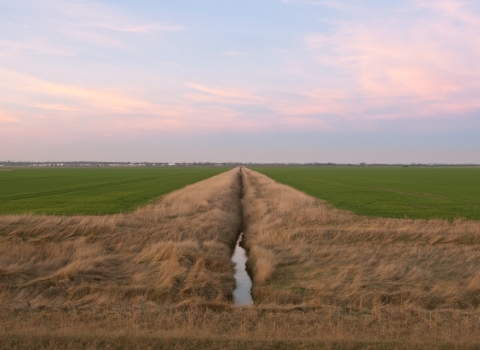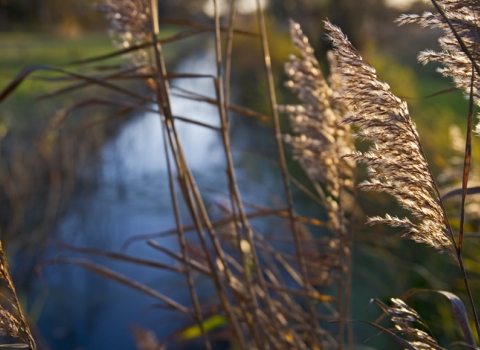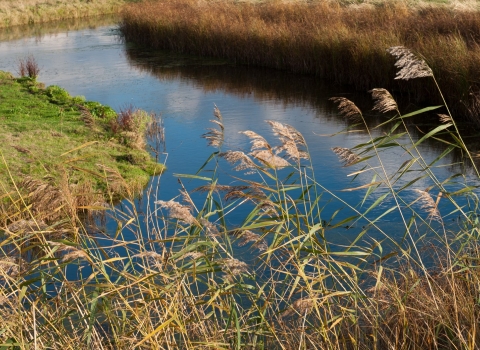The rain-drenched lands of the UK offer perfect conditions for the formation of wetlands. These places where water and dry land meet are home to a wide range of species, from dragonflies and damselflies, to wading curlew and snipe; from carnivorous plants to flitting butterflies. Wetlands are fantastic places to spot a huge variety of birds, so make sure that you take your binoculars along with you.
Wetlands also act as natural sponges, helping to soak up water after rainfall and reducing the risk of flooding. One of the goals of the Great Fen is to provide a natural defence against flooding that can protect local communities during extreme weather events. Wetlands are also one the best ways to trap greenhouse gases, helping mitigate the effects of climate change.

Reed warbler (Acrocephalus scirpaceus) adult in reedbed. Norfolk. - Chris Gomersall/2020VISION
Reedbeds
Reedbeds are areas of vegetation that are dominated by common reed. Over time reedbeds naturally dry out as plant litter builds up and become overgrown by scrub and then woodland. Traditionally reedbeds were managed as people used them for thatching and basket making, which stopped them reverting to woodland. To preserve these habitats that management process needs to be continued.
Colourful fen plants such as yellow flag iris and purple loosestrife occur in the richer areas and the reedbed plants support a vast array of invertebrates. Reedbeds are one of the most important habitats for birds, providing secure breeding sites for reed and sedge warblers and roosting sites for several raptor species. The largest existing area of reedbed is in the northern part of Woodwalton Fen. An elevated bird hide provides a superb way of seeing and hearing wildlife such as the resident marsh harriers. New reedbeds have now been created at Rymes Reedbed (170 ha) near Holme Fen, where there is another elevated bird hide, and at Kester's Docking.
Woodwalton Fen - Robert Enderby
Open water
Open water is important for an immense range of animals and plants. Woodwalton Fen and Holme Fen already have meres, which are used by a variety of species including many wildlfowl such as little and great crested grebe, tufted duck, pochard, mallard and coot. Fish in the meres and in Great Raveley Drain provide food for Otters and birds such as kingfishers, grey herons, bitterns and occasional wintering goosander.
The image right shows a large pond in the northern part of Woodwalton Fen. There are also small ponds and a great network of ditches that are used to control water levels. Water Voles are sometimes recorded and the reeds along the edges provide breeding habitat for water beetles, dragonflies, damselfies, and amphibians including the great crested newt. Woodwalton Fen and Holme Fen hold some of the largest areas of open water on the Great Fen.

Margins of arable land with ditch. Wallasea Island, Essex - Terry Whittaker/2020VISION
Restoring watercourses
The Great Fen has inherited a complex and efficient network of drains, dykes and ditches whose primary purpose has been to get water away from the arable farmland as quickly as possible. But now a major aim of the project is to retain water, rather than to drain it away. Ideally, excess water will be taken from the main drains during the winter and retained on the Great Fen area throughout the summer months.
In order to measure the water table (the level of water underground) we install dipwells. These are tubes which sit vertically in the ground and are drilled full of small holes to allow them to fill with water, which can then be measured.

David Tipling - Reed and Dyke along main drove at Woodwalton Fen
Flood protection
As the climate changes, it is predicted that there will be more extreme periods of heavy rainfall, leading to an increased risk of flooding when water can’t be pumped out to sea fast enough. Woodwalton Fen is used to temporarily store water during heavy rainfall but is too small to cope with the more extreme rainfall events predicted in the future.
The Environment Agency and Middle Level Commissioners, two of the Great Fen partners, are working to create new water storage areas in the Great Fen area for times of heavy rainfall. These will provide larger areas than are currently available for emergency storage, and will take the pressure away from Woodwalton Fen. This is part of a scheme to protect thousands of acres of surrounding farmland and communities.
